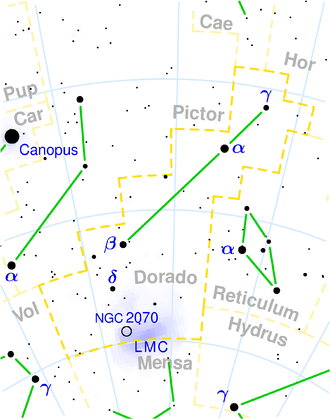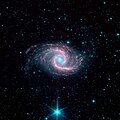NGC 1566
| Galaxy data from NGC 1566 |
|
|---|---|

|
|
| Ultraviolet absorption using GALEX | |
| AladinLite | |
| Constellation | Swordfish |
|
Position equinox : J2000.0 , epoch : J2000.0 |
|
| Right ascension | 04 h 20 m 00.4 s |
| declination | -54 ° 56 ′ 16 ″ |
| Appearance | |
| Morphological type | (R'_1) SAB (rs) bcSy1 |
| Brightness (visual) | 9.4 mag |
| Brightness (B-band) | 10.2 mag |
| Angular expansion | 8.2 ′ × 6.5 ′ |
| Position angle | 60 ° |
| Surface brightness | 13.6 mag / arcmin² |
| Physical data | |
| Affiliation | Dorado Group, LGG 114 |
| Redshift | 0.005017 ± 0.000007 |
| Radial velocity | 1504 ± 2 km / s |
|
Stroke distance v rad / H 0 |
(59 ± 4) · 10 6 ly (18.2 ± 1.3) Mpc |
| history | |
| discovery | James Dunlop |
| Discovery date | May 28, 1826 |
| Catalog names | |
| NGC 1566 • PGC 14897 • ESO 157-20 • IRAS 04189-5503 • GC 844 • h 2635 • Dun 338, LDCE 0328 NED011 | |
NGC 1566 is a barred spiral galaxy of the Hubble type SBbc in the constellation Swordfish in the southern sky . The galaxy is approximately 59 million light years from the Milky Way and is approximately 170,000 light years across .
Several measurements that are not based on redshift give a distance of 9.5 ± 4.6 Mpc (about 31 million light years), which is outside the distances calculated with the value of the shift.
It is classified as a Seyfert galaxy type 1.5, whose central black hole accretes huge amounts of matter and thus emits intense radiation, as it heats up to extremely high temperatures. NGC 1566 is the second brightest Seyfert galaxy known to us after Messier 77 . It is also the brightest object in the Dorado group .
The galaxy was discovered by the Scottish astronomer James Dunlop on May 28, 1826 .
High-resolution image of the center of NGC 1566, taken with the Hubble space telescope
Appearance of the center in the infrared , taken with the Spitzer Space Telescope .
NGC 1566 group ( LGG 114 )
| Galaxy | Alternative name | Distance / million ly |
|---|---|---|
| NGC 1536 | PGC 14620 | 47 |
| NGC 1581 | PGC 15055 | 64 |
| NGC 1596 | PGC 15153 | 60 |
| NGC 1602 | PGC 15168 | 62 |
| IC 2058 | PGC 14824 | 54 |
| PGC 15149 | ESO 157-030 | 58 |
| NGC 1566 | PGC 14897 | 59 |
Web links
- Spitzer space telescope
- Antilhue - Chile
- Rosat
- astronews.com: Picture of the day June 3, 2014
- SIMBAD Astronomical Database


